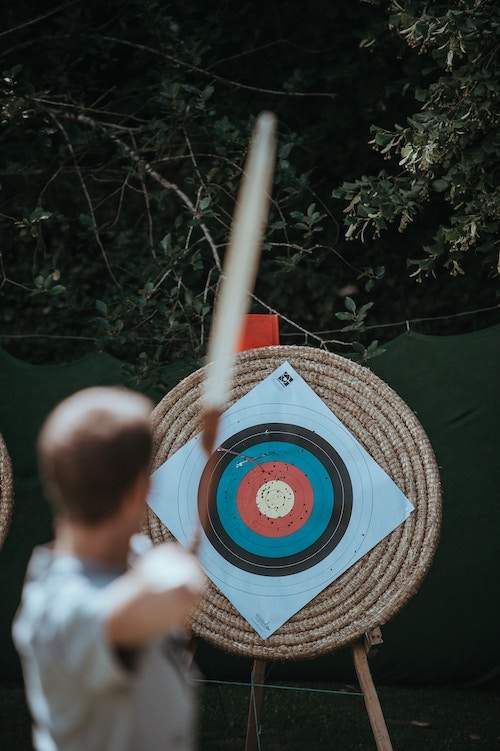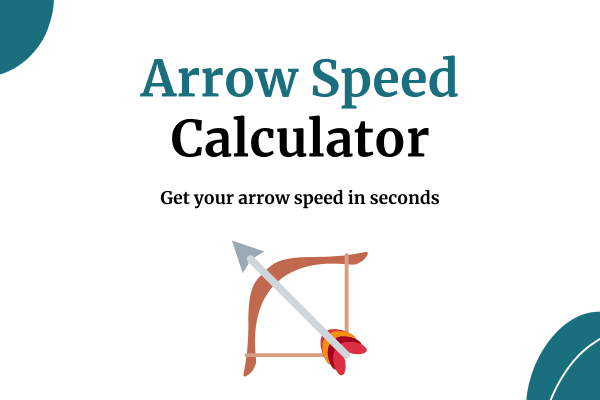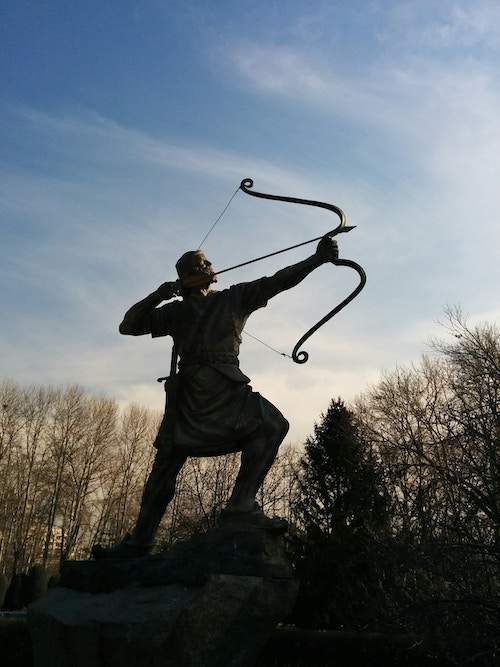Are you an archer who’s looking to understand your arrow speed? Well, I built a brand-new Arrow Speed Calculator that you can use! It even gives you a range of benchmarks so you can figure out how you stack up against other archers!
Archery Calculator
Actual Arrow Speed:
Momentum:
Kinetic Energy:
Arrow Speed Reference

Introducing the Arrow Speed Calculator
When it comes to archery, knowledge is power. The more you know about your equipment and how it performs, the better off you’ll be to hone your skills and hit your mark.
And one key piece of knowledge is your arrow’s speed, because it’s directly related to how far an arrow will travel through the air.
So, today I’m thrilled to give you a tool that makes this process easier than ever: the Arrow Speed Calculator.

The Basics of Arrow Speed
Arrow speed is often measured in feet per second (fps). It is the rate at which an arrow travels from your bow to the target.
It’s influenced by a ton of factors, such as draw length, bowstring weight, arrow weight, and draw weight.
Therefore, the faster your arrow flies, the flatter and more accurate your trajectory becomes.
Understanding the Arrow Speed Calculator
The Arrow Speed Calculator is an easy-to-use, interactive tool that gives precise calculations based on your unique archery setup.
The calculator estimates your arrow’s actual speed, momentum, and kinetic energy—three key components that affect your arrow’s performance.
Let’s break down what these components mean:
- IBO Speed (ft/s): The speed rating of your bow, usually provided by the manufacturer.
- Draw Length (inches): The distance from the nock point to the throat of the grip plus 1 3/4 inches.
- Bowstring Weight (grains): The weight of your bowstring, typically in grains.
- Arrow Weight (grains): The total weight of your arrow, including the point, shaft, fletching, and nock.
- Draw Weight (pounds): The peak amount of weight an archer pulls while drawing the bow.
The calculator’s results include:
- Actual Arrow Speed (ft/s): The speed your arrow will likely travel based on the inputs you’ve provided.
- Momentum (grain*ft/s): A measure of the force your arrow will exert on the target.
- Kinetic Energy (grain*ft^2/s^2): The energy your arrow carries in flight, which translates into its penetration power.

How the Arrow Speed Calculator Works
The Arrow Speed Calculator works by taking your inputs and applying them to a formula, integrating IBO speed, draw length, bowstring weight, arrow weight, and draw weight.
The results are then compared to a standard speed scale—Excellent (>300 ft/s), Good (250-300 ft/s), Average (200-250 ft/s), and Below Average (<200 ft/s)—to provide an accurate, easy-to-understand snapshot of your arrow’s performance.
A Step-By-Step Guide on How to Use the Arrow Speed Calculator
Using the Arrow Speed Calculator couldn’t be easier. Here’s a quick guide:
- Enter your IBO speed (in ft/s) in the first input field.
- Next, input your draw length (in inches).
- Continue by entering your bowstring weight (in grains).
- Now, add your arrow weight (also in grains).
- Lastly, enter your draw weight (in pounds).
- Hit the “Calculate” button and review your results!
The results give a comprehensive report of your arrow’s actual speed, momentum, and kinetic energy, complete with a speed rating.
The Difference between Arrow Speed, Momentum, and Kinetic Energy
Arrow speed, momentum, and kinetic energy are three related but distinct factors:
- Arrow Speed is the velocity of your arrow in flight. Therefore, higher speed results in a flatter trajectory and better accuracy.
- Momentum is a measure of the arrow’s mass and speed combined. An arrow with high momentum will maintain its velocity better as well as provide greater penetration.
- Kinetic Energy is the energy an arrow carries in flight, calculated based on both its speed as well as weight. The greater the kinetic energy, the even more damage potential upon hitting the target.
Understanding these three factors can help certainly help you improve as an archer!

How to Improve Your Arrow Speed
Improving your arrow speed can often come down to adjusting your equipment and form. Here are a few tips:
- Optimize Draw Weight: A higher draw weight leads to a faster arrow speed, assuming you can handle the weight. Remember, an uncomfortable draw weight can lead to poor form and reduced accuracy.
- Adjust Draw Length: A longer draw length can increase arrow speed. However, like draw weight, your draw length should be comfortable to maintain proper shooting form.
- Choose the Right Arrow Weight: Lighter arrows fly faster, but heavier arrows carry more momentum. Finding the right balance between speed and momentum is key.
- Maintain Your Equipment: Regular maintenance of your bowstring and arrow can also improve your arrow speed. Frayed bowstrings or damaged arrows can drastically reduce speed.
Wrapping Up
To sum up, understanding arrow speed and its allied factors—momentum and kinetic energy—is essential for any archer looking to improve their game. Our Arrow Speed Calculator makes it simple to get a grip on these elements, giving you the knowledge to optimize your equipment and technique for maximum performance.
Remember, while the pursuit of speed is essential, it shouldn’t come at the cost of comfort, safety, or accuracy. A balanced approach, taking into account all aspects of your archery equipment and style, will yield the best results.
By the way, we have tons of other great calculator tools for you to use, such as the ERA Calculator, the WHIP Calculator, the Batting Average Calculator, the OPS Calculator and many more. Have a look around 🙂
Happy shooting, and may your arrows always find their mark!
Frequently Asked Questions (FAQs)
1. Is a faster arrow always better?
While a faster arrow offers a flatter trajectory and less wind drift, it’s not always ‘better’. The weight of the arrow and the archer’s ability to comfortably handle the bow at a given draw weight are equally, if not more, important.
2. How does arrow weight affect speed and momentum?
A lighter arrow will generally travel faster, providing a flatter trajectory. However, a heavier arrow, while slower, will carry more momentum and may penetrate the target better.
3. Can I use the Arrow Speed Calculator for crossbows?
The Arrow Speed Calculator is designed for use with traditional and compound bows. However, it may still provide useful insights for crossbow users, although some variables, like draw length, may not apply. Always consult your crossbow manufacturer for the most accurate information.